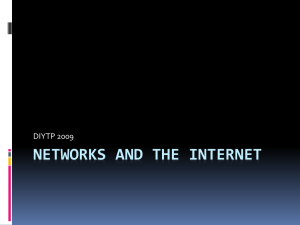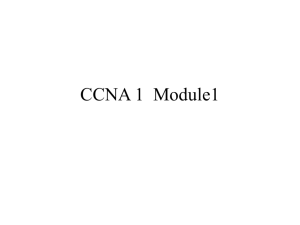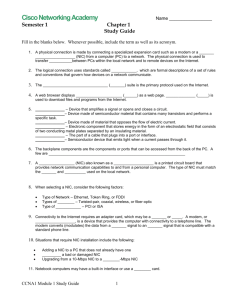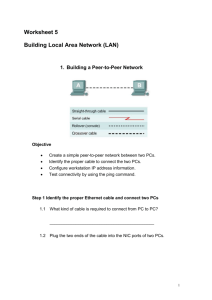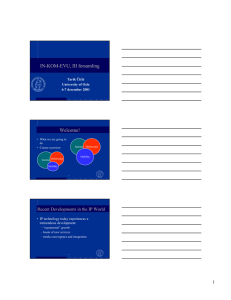Connecting to the Internet Pertemuan 1 1
advertisement
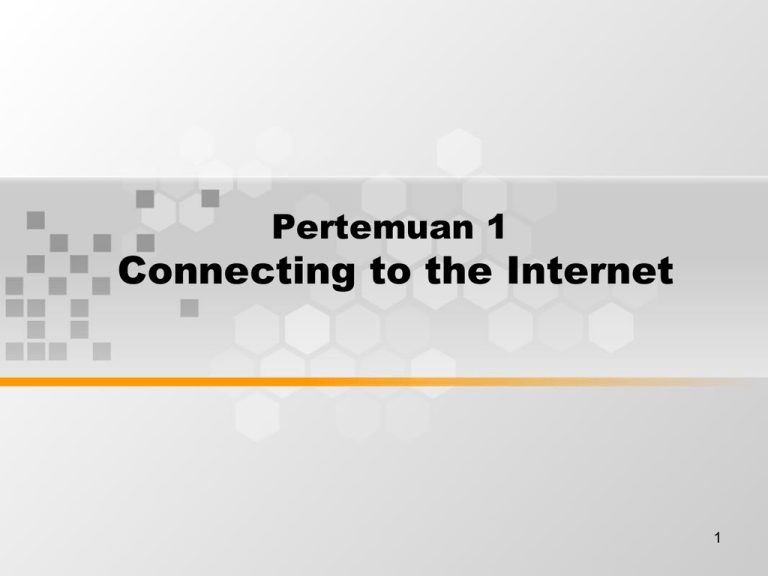
Pertemuan 1 Connecting to the Internet 1 Discussion Topics • • • • • • • • • Requirements for Internet connection PC basics Network interface card NIC and modem installation Overview of high-speed and dial-up connectivity TCP/IP description and configuration Testing connectivity with ping Web browser and plug-ins Troubleshooting Internet connection problems 2 Requirements for Internet Connection • A physical connection is made by connecting a specialized expansion card such as a modem or a network interface card (NIC) from a computer (PC) to a network. • The logical connection uses standards called protocols. • The application that interprets the data and displays the information in an understandable form is the last part of the connection. – Web browser – File Transfer Protocol (FTP) 3 PC Basics Personal Computer Subsystems Backplane Components • Printed circuit board (PCB) • Backplane • CD-ROM drive • Network interface card (NIC) • Central processing unit (CPU) • Video card • Floppy disk drive • Audio card • Hard disk drive • Parallel port • Microprocessor • Serial port Mouse port • Motherboard • Power cord • Bus • Random-access memory (RAM) • Read-only memory (ROM) • System unit • Expansion slot • Power supply 4 PC Basics 5 PC Basics 6 PC Basics 7 PC Basics PCI Expansion Slots AGP Expansion Slot 8 Network Interface Cards 9 NIC and Modem Installation • A modem, or modulatordemodulator, is a device that provides the computer with connectivity to a telephone line. • PCMCIA wired and wireless NICs. • Desktop systems may use an internal or external NIC. 10 High-Speed and Dialup Connectivity • Inevitably the high-speed services used in the corporate environment, such as Digital Subscriber Line (DSL) and cable modem access, moved to the consumer market. • These services no longer required expensive equipment or a second phone line. • These are "always on" services that provide instant access and do not require a connection to be established for each session. • This gives greater reliability and flexibility, and has led to the ease of Internet connection sharing by small office and home networks. 11 TCP/IP Description and Configuration • Transmission Control Protocol/Internet Protocol (TCP/IP) is a set of protocols or rules developed to allow cooperating computers to share resources across a network. 12 TCP/IP description and configuration 13 TCP/IP description and configuration 14 Testing Connectivity with Ping • The ping command works by sending multiple IP packets to a specified destination. Each packet sent is a request for a reply. • The ping command is used to test the NIC transmit/receive function, the TCP/IP configuration, and network connectivity. 15 Web Browser and Plug-Ins Sample of plug-in applications • These applications work in conjunction with the browser to launch the program required to view the following special files: • Flash – plays multimedia files, which was created by Macromedia Flash • Quicktime – plays video files, which was created by Apple • Real Player – plays audio files 16 Troubleshooting Internet Connections 17 Summary • Three requirements for an Internet connection are physical connection, a logical connection and a Web browser. 18
